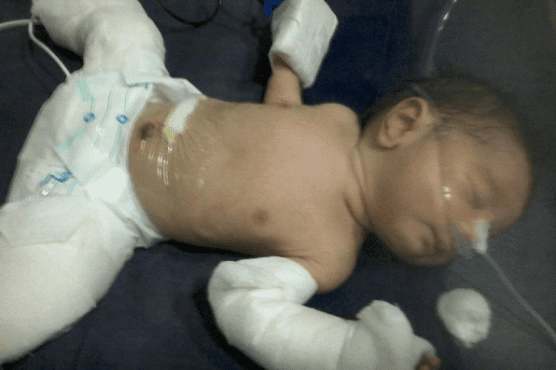
A baby boy born recently in India came into the world 'pregnant' with his own twin. His story may sound like horror or science fiction, but it's his reality.
The incredible circumstance is extremely rare — similar cases have only happened about 200 times in recorded medical history.
An astounding phenomenon
Doctors found the babe's partially formed twin brother — complete with limbs and a brain - behind his stomach. Surgeons successfully operated to remove the encased twin, which was a 7 cm, 150 g mass deemed a fetus in fetu.
"It was inside a fetal sac of the newborn," said Radiologist Dr Bhavna Thorat, who was the first to spot the problem during a routine pregnancy check up.
Thorat said he could see the twin's bones and a tiny head with a brain during the mother's prenatal scan.
"However, this parasitic twin didn't have a skull bone," Thorat said.
A parasite
It may sound harsh to describe the twin who did not survive as a 'parasite,' but that's exactly what it was.
The mom's gynecologist, Dr. Neena Nichlani, said this was a "case of monozygotic twin pregnancy sharing single placenta, where one fetus wraps itself around and envelops the other and robs the host of its nutrition."
Luckily, despite the undeveloped twin's parasitic nature, the surviving brother stayed alive long enough to be born and have surgery to remove the twin. He endured the surgery safely and is recovering well.
Fetus in fetu
Though very few cases of fetus in fetu have occurred, medical professionals have researched the phenomenon extensively. It's classified as a condition in which a malformed and parasitic fetus is located anywhere in the body of its twin.
Monozygotic twin pregnancies usually involve the parasitic sibling implanted in the other sibling's skull, tailbone or abdomen. It can lead to death for both twins, as the parasite takes necessary nutrients away from the host.
The anomaly was first defined in early nineteenth century, and the parasitic twin must be advanced enough to have a spinal column to be defined as a fetus in fetu. Medical professionals have determined that complete removal of the mass and its capsule is the best way to treat babies with this condition.
Other cases
Other recorded cases of fetus in fetu include a female newborn whose twin wasn't discovered until 10 days after she was born.
Doctors operated on the 10 x 15 cm mass in her abdomen and found a parasitic twin with "skin, skin extensions, glial tissue, striated muscle, mature cartilage, peripheral nerve, lung tissue, bone and bone marrow tissues in the capsule."
In another case, a mother of a 3-week-old baby noticed a lump on her son's buttocks. A week later, he was in for surgery for removal, and surgeons found a capsule.
The surgeons reported, "in the capsule, there was a hairy trunk with a size of 5-6 cm and two extremities, which had fingers and nails at the ends."
Miraculously, both babies survived, just as the recent newborn from India. All three are reported to be growing up happy and healthy.

